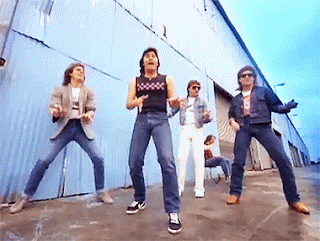 |
| Finding Your Feet, a comedy featuring Dolores Umbridge, apparently... |
Welcome to this library of…posts about popular music. Unfortunately, I’ll have to start this with an explanation.
At the time I’m posting this little (for now) index, I’ve written a total of 57 posts for this site. 20 of those were devoted to the One Hit No More Project (and here’s the library for that one, which will grow just like this one), which leaves 37 posts about…other things. I changed both topics and formats between those posts, covering just one band/artist here, and building a post a round a playlist with multiple artists there. Call it a long process of finding my feet – which I think I have going into 2020 (also, I make regular claims to have found my feet, but they keep going missing all the same).
In order to lend both this library and posts I intend to write in the future some thematic coherence, I’ve decided to limit this index to posts in which I focused on one band/artist. (And, in accordance with future plans, I will create a separate index for those playlist posts.) About those posts…
While I cover a decent variety of bands/artists, the majority of them come from “indie ______” genres – e.g., “indie rock,” “indie hip hop,” and “indie pop,” with various sub-genres in between. Those will be the same kinds of artists I look into going forward too. At any rate, links to all the posts of this sort that I’ve written so far are linked to down below. As I write more posts going forward, I’ll add them to this post with semi-regularity to keep this library current.
Finally, you’ll see a bunch of different titles below, as well as a discontinued series or two. Going forward, I’ve decided to continue this under the “Crash Course” series, so the numbers will count up from there (and I dropped the hyphen in “Crash-Course”). That’s all, lots to read below - and listen to. Each post includes a short-ish history of the relevant band/artist, as well as links to a bunch of their music. God bless, Youtube, right?
At the time I’m posting this little (for now) index, I’ve written a total of 57 posts for this site. 20 of those were devoted to the One Hit No More Project (and here’s the library for that one, which will grow just like this one), which leaves 37 posts about…other things. I changed both topics and formats between those posts, covering just one band/artist here, and building a post a round a playlist with multiple artists there. Call it a long process of finding my feet – which I think I have going into 2020 (also, I make regular claims to have found my feet, but they keep going missing all the same).
In order to lend both this library and posts I intend to write in the future some thematic coherence, I’ve decided to limit this index to posts in which I focused on one band/artist. (And, in accordance with future plans, I will create a separate index for those playlist posts.) About those posts…
While I cover a decent variety of bands/artists, the majority of them come from “indie ______” genres – e.g., “indie rock,” “indie hip hop,” and “indie pop,” with various sub-genres in between. Those will be the same kinds of artists I look into going forward too. At any rate, links to all the posts of this sort that I’ve written so far are linked to down below. As I write more posts going forward, I’ll add them to this post with semi-regularity to keep this library current.
Finally, you’ll see a bunch of different titles below, as well as a discontinued series or two. Going forward, I’ve decided to continue this under the “Crash Course” series, so the numbers will count up from there (and I dropped the hyphen in “Crash-Course”). That’s all, lots to read below - and listen to. Each post includes a short-ish history of the relevant band/artist, as well as links to a bunch of their music. God bless, Youtube, right?
















